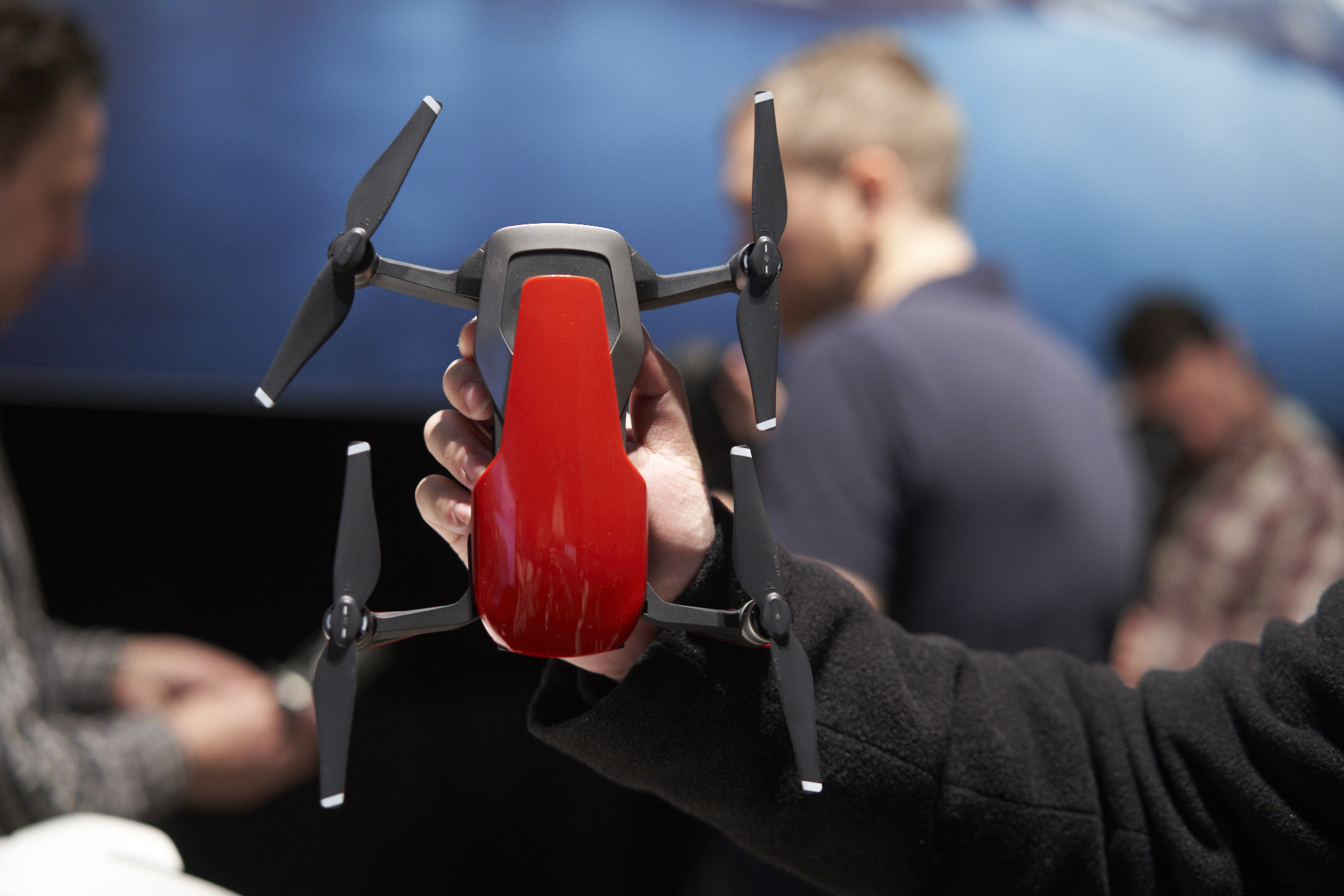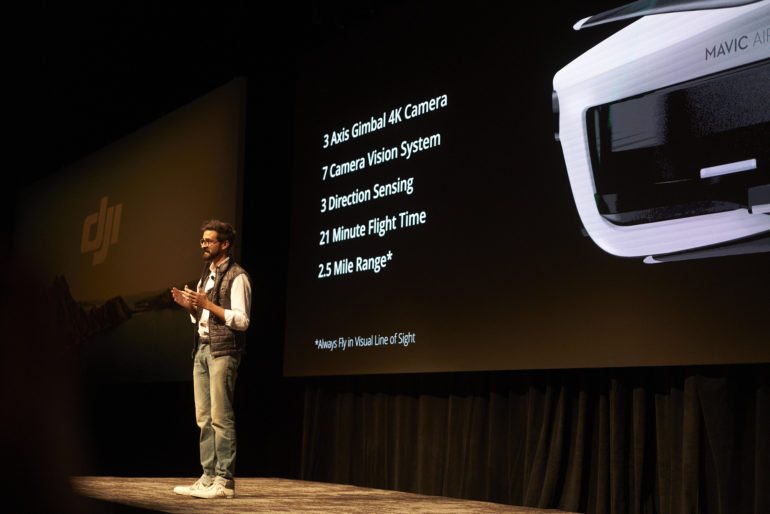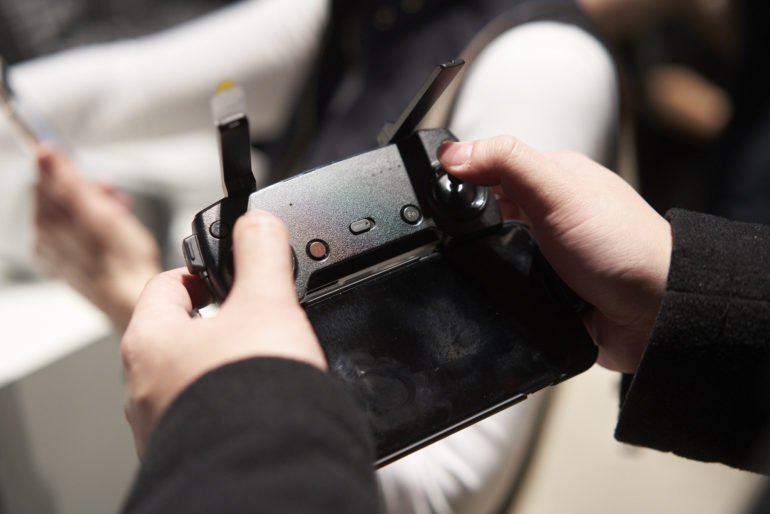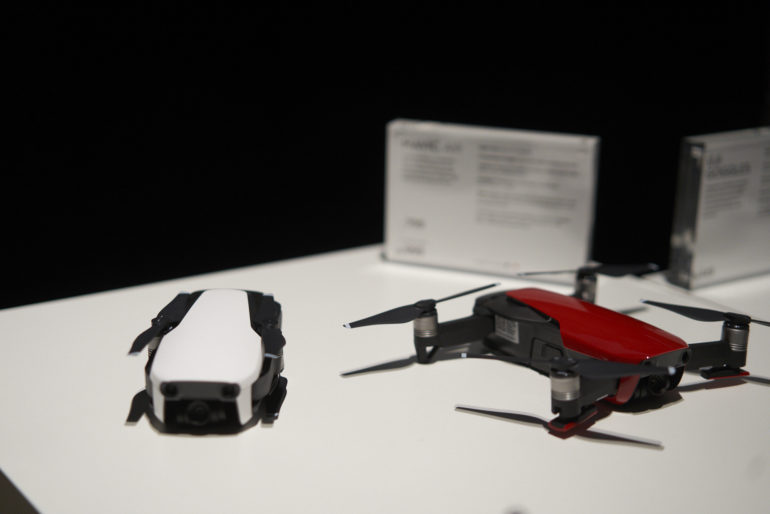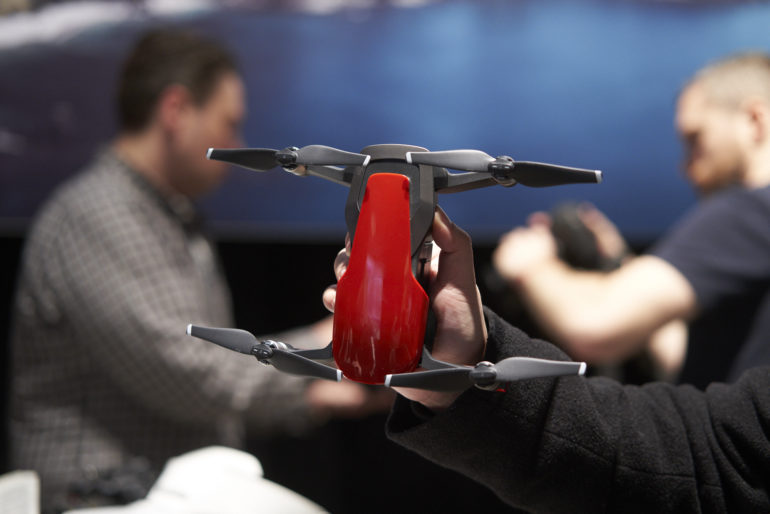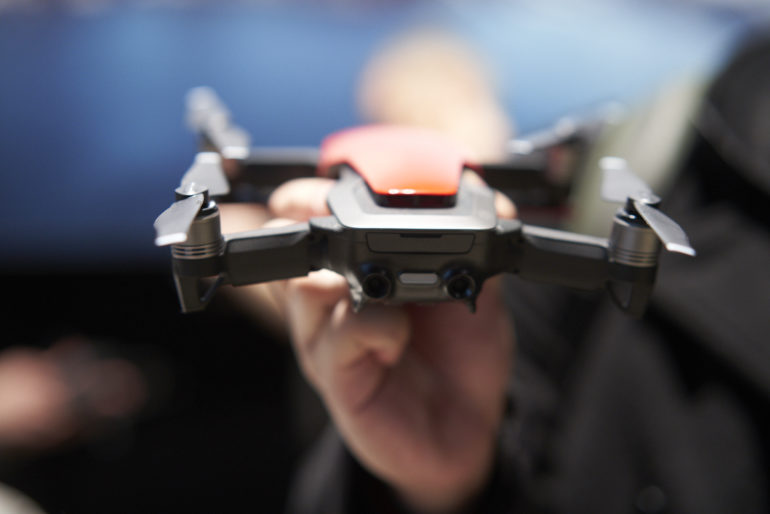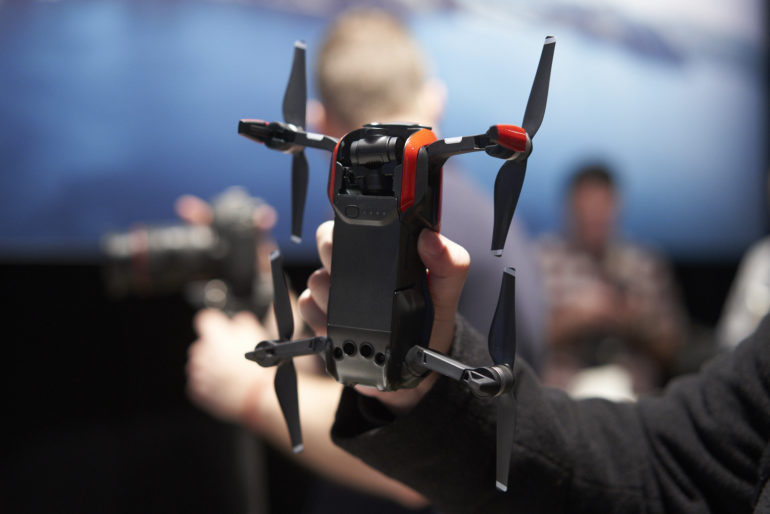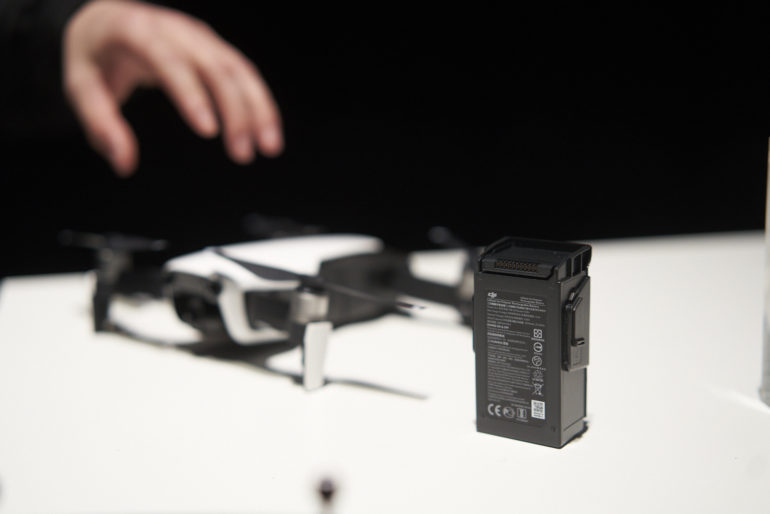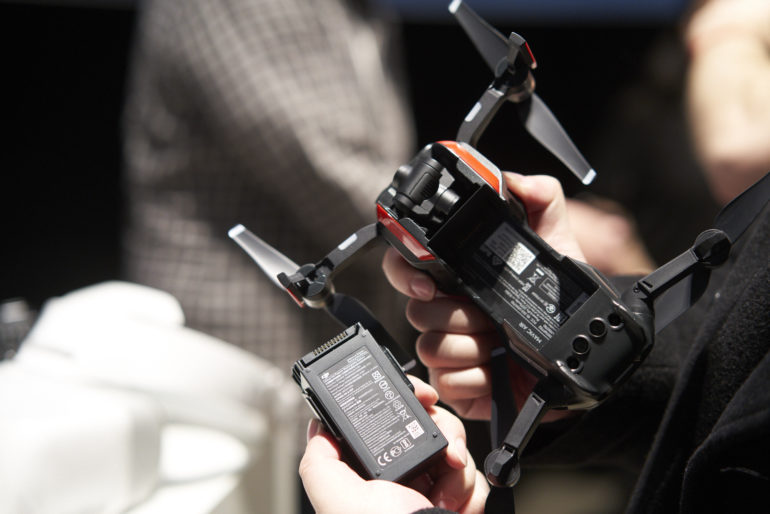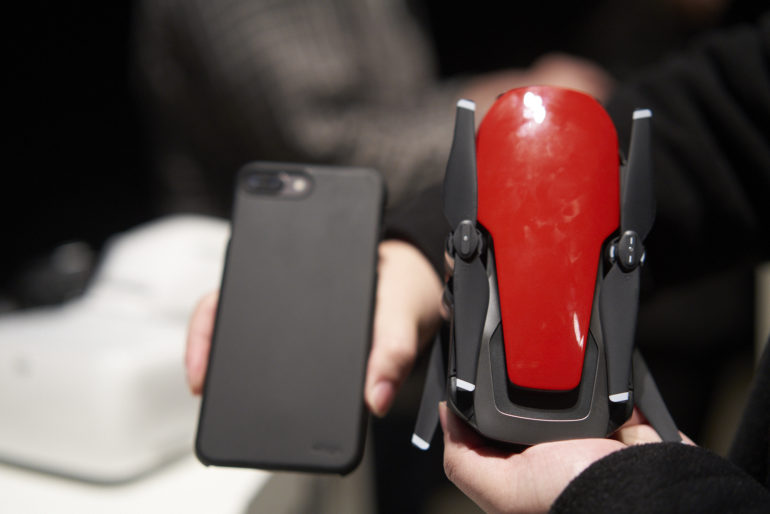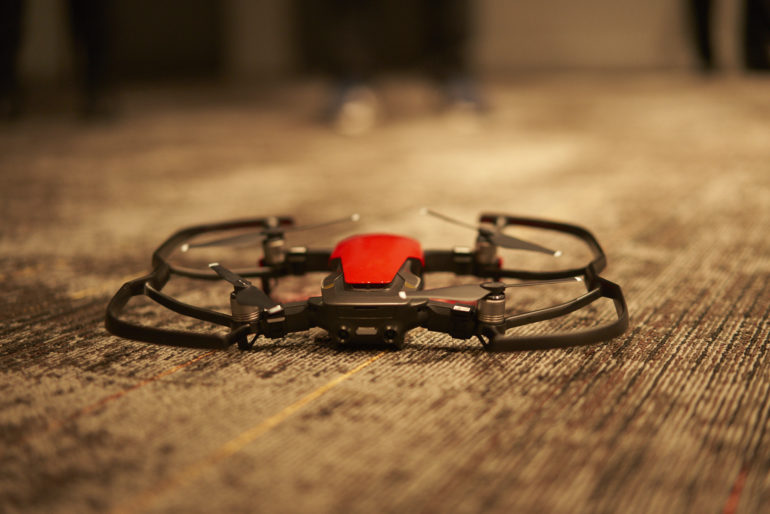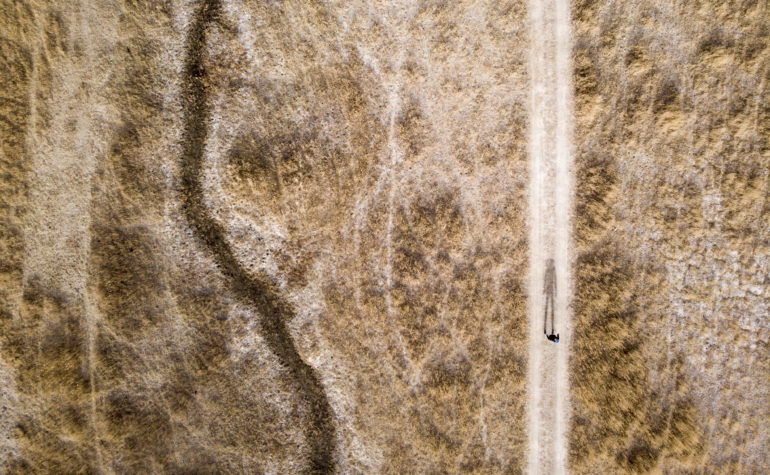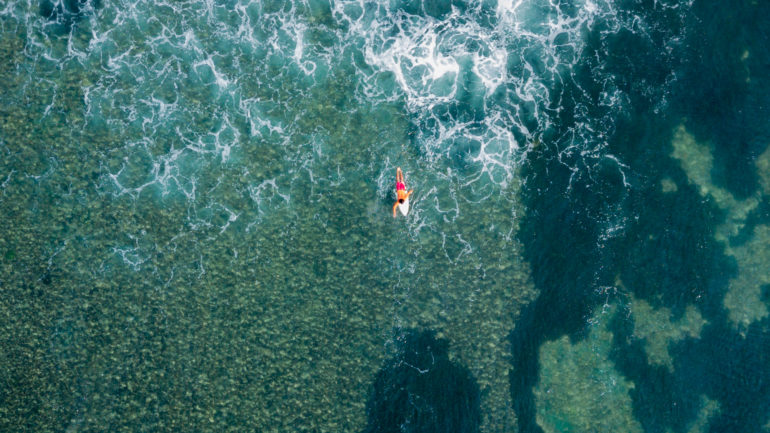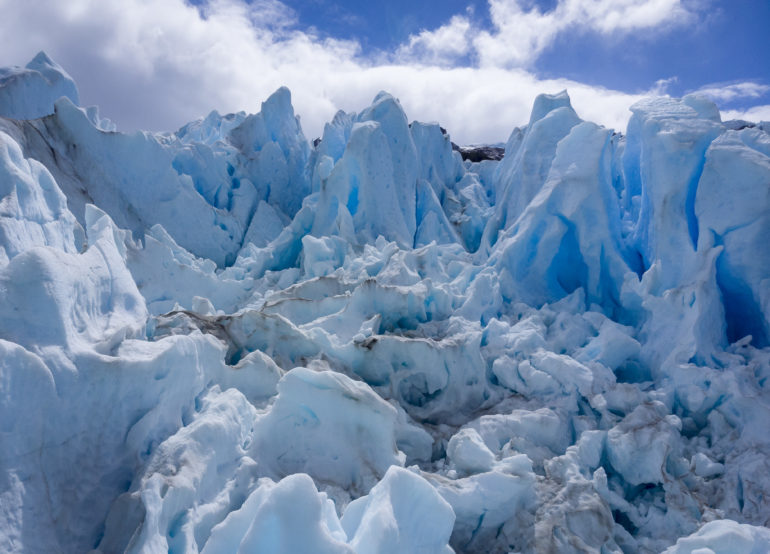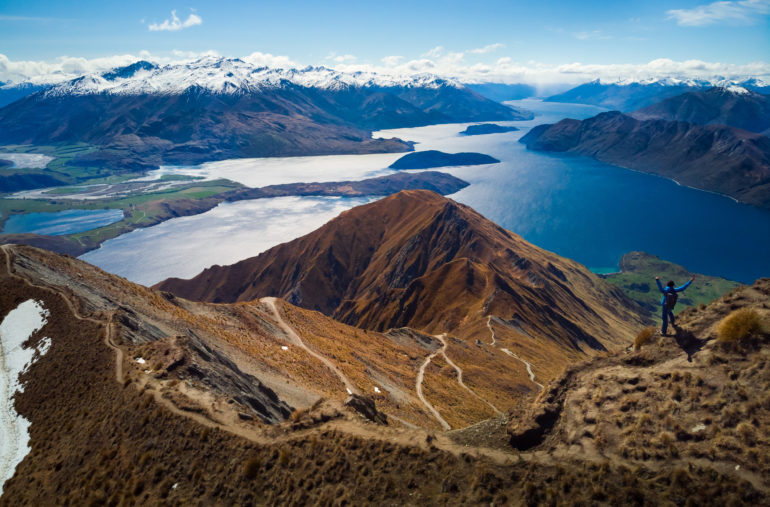Last Updated on 01/23/2018 by Mark Beckenbach
The new DJI Mavic Air is so small it can fit into a coat pocket with ease.
Today, the new DJI Mavic Air was announced to an absolutely astounded crowd. Designed to be put into a coat pocket and carried anywhere along with the remote, your phone, and all the other stuff you normally bring with you, the new DJI Mavic Air also brings with it a lot of technology. For starters, there is a three axis gimbal that works in conjunction with the 12MP camera. At the heart of the camera is a 1/2.3″ CMOS sensor – not that big, we know – but everything you’re shooting also has a very deep perspective. There are cameras and sensors all over the body to help protect it from crashing into things. Additionally, the antennae were designed to be fit into the landing gear yet face outward to ensure that the signal connection stays strong. It’s designed to be high wind resistant and has some pretty cool features such as a smart pathing technology and hand gestures that are built in.
The new DJI Mavic Air also has a few really cool features such as the ability to create 36MP panoramic images in addition to 4K video at a number of resolutions.
Tech Specs
The full tech specs can be seen over at the DJI Mavic Air website.
CAMERA SPECS
| Sensor | 1/2.3” CMOS Effective Pixels: 12 MP |
|---|---|
| Lens | FOV: 85° 35 mm Format Equivalent: 24 mm Aperture: f/2.8 Shooting Range: 0.5 m to ∞ |
| ISO Range | Video: 100 – 1600 (auto) 100 – 1600 (manual)Photo: 100 – 1600 (auto) 100 – 3200 (manual) |
| Shutter Speed | Electronic Shutter: 8 – 1/8000s |
| Still Image Size | 4:3: 4056×3040 16:9: 4056×2280 |
| Still Photography Modes | Single shot HDR Burst shooting: 3/5/7 frames Auto Exposure Bracketing (AEB): 3/5 bracketed frames at 0.7EV Bias Interval: 2/3/5/7/10/15/20/30/60 s |
| Video Resolution | 4K Ultra HD: 3840×2160 24/25/30p 2.7K: 2720×1530 24/25/30/48/50/60p FHD: 1920×1080 24/25/30/48/50/60/120p HD: 1280×720 24/25/30/48/50/60/120p |
| Max Video Bitrate | 100Mbps |
| Supported File System | FAT32 |
| Photo Format | JPEG/DNG (RAW) |
| Video Format | MP4/MOV (H.264/MPEG-4 AVC) |
Ergonomics
The DJI Mavic Air has a brand new controller. It’s super small and the thumb joysticks are removable (you’ll need to screw them into the controller in order to use it). Alternatively, you can control the DJI Mavic Air with your phone, but you won’t get the fine finesse that I feel you can with a good old analog controller.
The DJI Mavic Air comes in three colors: White, black and red. The red is pretty cool but I feel like the white may be the most popular option. This drone is incredibly small and highly capable.
To get the DJI Mavic Air going, you’ll need to unfold the legs. The front legs go in first and then the back legs sort of fold in under them. The blades don’t collapse to become smaller – unlike the DJI Spark. Of course, you can see here with the red body that when it’s in the air, it will be very hard to miss.
Turn towards the front of the DJI Mavic Air and what you’ll spot is the camera. This camera is connected to a three way gimbal and there are other sensors around it. Like all the other DJI drones, the camera can be operated via your phone or your remote.
Then there’s the bottom of the DJI Mavic Air. You’ll see how plain Jane it is here. But an important thing you may not notice is that most of this area is actually the battery. Around the rest of it are sensors and such.
In fact, here’s what that really big battery looks like. It’s larger than the DJI Spark’s, that’s for sure.
To show you just how much of an area it takes up, here is a view of the DJI Mavic Air with the battery removed. It’s quite big in comparison to the image above.
When the DJI Mavic Air is folded up, it can fit into a jacket pocket pretty easily. In fact, it’s around the size of an iPhone X.
Build Quality
DJI states that the DJI Mavic Air is designed to deal with very high speed winds and it can also take off from really high altitudes. That means that if you’re hiking in the mountains, you’ll have a really easy time working with this drone. Pretty crazy, right? All this for $799.
Ease of Use
The DJI Mavic Air has controls that really remind me of the DJI Spark’s in some ways. But the DJI Mavic Air takes them a step further. You can control the distance of the drone to you, use some of the same controls to make it take images, have it follow you, etc. I didn’t get to use it fully on the showroom floor and what we played with I believe were prototypes. There are many other things that you can do too such as panoramas and basically creating Tiny planet images; but I need to test out how simple that is for myself.
Image Quality
Here are some sample images that DJI has provided for the press.
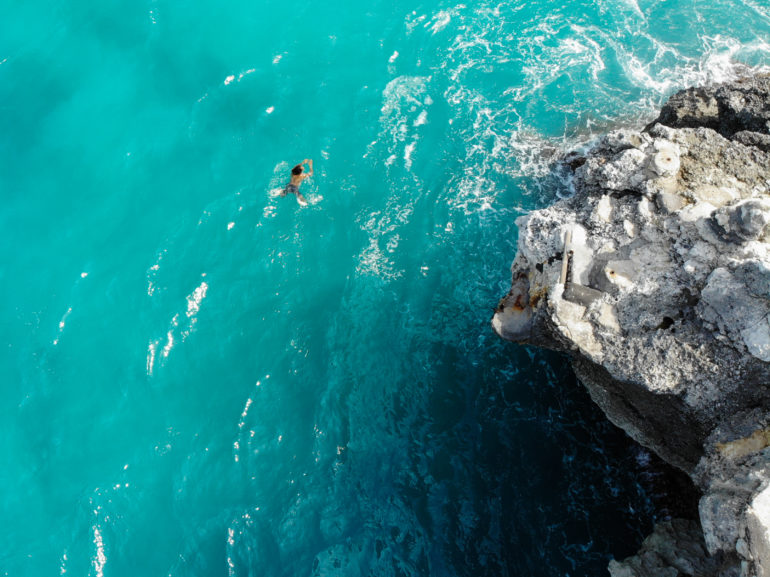
First Impressions
I’ve purposely held out for a drone for years because I wanted something small, lightweight, strong, and with 4K video at 24p. If I were to get a drone, this is honestly the one I’d be considering the most. But as a resident in NYC, we’ve got a whole lot of areas where we’re not allowed to use them at all. So I’d only be able to use them in certain areas legally. Sure, lots of folks use them illegally, but not everyone is a professional blogger with a lot of credibility on the line – I’d rather be safe than sorry. We shoot a number of videos on press trips, so it would be very useful in that regard for sure.
So far, I’m very impressed with the DJI Mavic Air. I really like it and I’m tempted to pick one up; but I’ll need to wait until after I hopefully get that tax return check.
DJI Introduces Mavic Air For Limitless Exploration Wherever Adventure Takes You
The Most Portable 3-Axis Gimbal 4K Camera Drone Features SmartCapture, FlightAutonomy 2.0 And Advanced Pilot Assistance Systems
January 23, 2018 – DJI, the world’s leader in civilian drones and aerial imaging technology, today introduced Mavic Air, an ultra-portable, foldable camera drone that delivers higher performance, more intelligent features and greater creative possibilities than any other consumer drone. Developed with the traveler and outdoor enthusiast in mind, Mavic Air inherits the best features of DJI’s iconic Mavic series with a 4K camera for superior image quality, new QuickShot modes and SmartCapture for easier, more intelligent photo and video capturing, and FlightAutonomy 2.0 with Advanced Pilot Assistance Systems for smarter, safer flight. A marvel of engineering and design, Mavic Air enables limitless exploration wherever adventure takes you.
“When DJI introduced the Mavic Pro, it reinvented what a consumer drone could be: powerful, yet portable, accessible, but advanced,” said Roger Luo, President at DJI. “Today, with the introduction of Mavic Air, we have pushed these attributes to the next level to create our best consumer drone yet.”
Designed for Portability and Power
Weighing just 430 grams, Mavic Air is the most portable DJI drone ever created. Its folding arms and propellers sit flush against its slender aerodynamic frame, making it so compact that its footprint is nearly the size of a modern smartphone when folded.
Every aspect of Mavic Air’s camera has been designed for maximum performance. Its recessed three-axis mechanical gimbal is suspended from dampeners to further reduce vibration providing superior protection and steadier shots. A powerful camera housing a 1/2.3” CMOS sensor and the equivalent of a 24mm F2.8 lens (on a 35mm full frame sensor) captures high-quality photos and videos.
Mavic Air photographs crisp 12-megapixel still images utilizing new HDR algorithms that preserve more highlight and low light details, allowing you to capture stunning aerial pictures from sunrise to sunset. It also shoots smooth stabilized 4K video at 30 fps, capturing the highest quality video of any DJI consumer drone with a maximum bitrate of 100 Mbps. Preserving the action in dramatic fast-paced scenes is now possible through its ability to shoot 1080p slow-motion video at 120 fps.
Mavic Air is DJI’s first drone with 8 GB of onboard storage letting you save photos and videos directly to the aircraft on the go, plus a microSD card slot for additional storage capacity. The newly added USB-C port makes exporting captured footage easy and fast.
Expand Your Creativity
Mavic Air’s intelligent camera system creates new possibilities for anyone regardless of their photography and drone piloting experience. Photo enthusiasts who want to capture their surroundings in complete detail can use the new Sphere panorama feature to automatically shoot and stitch together 25 photos, creating a crystal-clear 32-megapixel panoramic image within one minute. Mavic Air also supports multiple panorama modes, creating horizontal, vertical, and 180-degree images.
QuickShot intelligent video modes make creating professional videos fun and easy with predefined flight paths that automatically keep your subject in the frame. Use Rocket, Dronie, Circle, or Helix plus two new modes Asteroid and Boomerang, to effortlessly create videos that once required significant piloting skills and sophisticated editing software. Asteroid starts with a spherical image that zooms in as it descends toward the subject on the ground, while Boomerang circles the subject in an oval-shaped flight path with the video finishing at the start point.

(Asteroid Mode Example)

(Boomerang Mode Example)
Mavic Air’s ActiveTrack intelligent flight mode has been improved to automatically sense multiple subjects, following your subject and keeping it in the frame with more precision, especially during high motion activities like running and cycling.
Powered by machine learning technology, SmartCapture[1] is an ultra-responsive control mode that makes shooting photos and videos effortless. With a maximum range of up to 20 ft (6 meters), you can give hand gesture commands to launch, follow, photograph, record, push, pull and land, letting you capture the moment from any angle without the need for a remote controller.
Smarter, Safer Flight
More powerful computing capabilities and optimized algorithms help Mavic Air fly smarter and safer through obstacles and terrain. FlightAutonomy 2.0 processes data gathered from seven onboard cameras and infrared sensors to construct a 3D map of its environment for more precise hovering and better flight performance. The improved forward and backward dual camera vision systems can sense obstacles up to 66 feet (20 meters) away. To help navigate through more complex outdoor environments, Mavic Air has newly developed Advanced Pilot Assistance Systems that helps pilots avoid and bypass obstacles automatically, providing an extra layer of reassurance during flight.
Mavic Air has a maximum flight time of up to 21 minutes. It can fly stably in windy conditions of up to 22 mph (36 kph) and at high elevations of up to 16,404 ft (5,000 m) above sea level[2]. Mavic Air’s remote is the first to feature detachable control sticks that can be stored inside the remote controller for added portability. Its omnidirectional antennas placed on the foldable landing gear help increase signal coverage to deliver a maximum range of up to 2.5 miles (4km)[3] with 1080p real-time video transmission when flying with the remote controller. When in Sport mode, Mavic Air flies at exhilarating speeds of up to 42 mph (68 kph) and is compatible with DJI Goggles for an immersive FPV flight experience.
Price and Availability
Mavic Air will be available in three colors: Onyx Black, Arctic White and Flame Red. The US retail price including the drone, battery, remote controller, carrying case, two pairs of propeller guards and four pairs of propellers, is $799 USD. The Mavic Air Fly More Combo includes the drone, three batteries, a remote controller, a travel bag, two pairs of propeller guards, six pairs of propellers, a battery to power bank adapter and battery charging hub, for $999 USD.
Starting today, Mavic Air will be available for pre-order at store.dji.com, the four DJI Flagship Stores and authorized dealers. Pre-orders will start shipping on January 28. For more information on all the new features and capabilities of Mavic Air, please visit www.dji.com/mavic-air.


